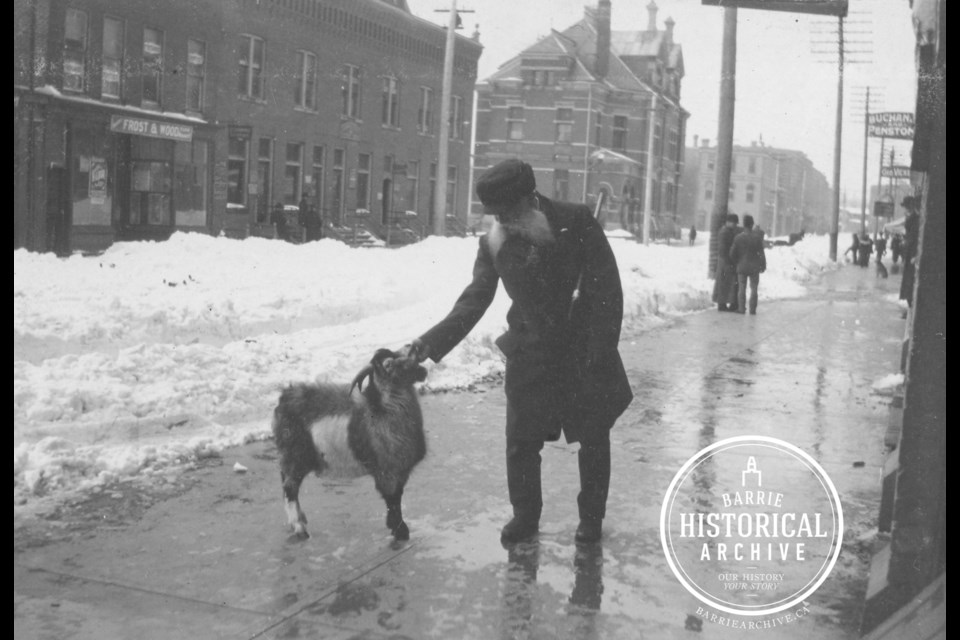This ongoing series from Barrie Historical Archive curator Deb Exel shows old photos from the collection and one from the present day, as well as the story behind them.
Maj. Joseph Rogers
These days, the ability to digitally record absolutely everything we see or do, whether an exciting or memorable event, something scenic, antics of the family pet, down to the most mundane of things, is always instantly at our fingertips. It is so automatic that we don’t even give a thought.
In contrast, imagine the remarkable chance that, in 1903, an ordinary citizen would happen to be carrying a camera when they met a prominent Barrie resident on the main street, capturing the completely unscripted moment, which we are now enjoying more than 120 years later.
Behold their rare photo of Maj. Joseph Rogers encountering the Clarkson House goat, while presumably on his way from his lovely home, Roselawn, to his work at the Registry Office.
Born about 1832 in Leeds, England, Rogers’s Sheffield branch of the family was known for its silverware. Rogers attended Spofforth boarding school, near Weatherby, in legendary steeplechase country. He made his way to Canada as a youth, the trip taking more than two months. It was a terrible journey: A number of the Irish passengers in steerage died during the trip, sickness occurred when the water supply ran out and sailors robbed Rogers of all his money.
Arriving broke in New York, Rogers worked his way to Toronto. Riding a construction train to the end of the line, Bradford, he hopped on the steamer Beaver, landing at O’Brien’s dock in Shanty Bay. Rogers worked on the Oro farm of his uncle, Robert Hodgson, and attended St. Thomas’ Anglican Church.
About 1852, when he was 19, Rogers joined the militia, his commission dating to 1856, when he made ensign in the No. 1 Rifle Company. He was a lieutenant in 1860 with the Queen’s Own Rifles, and was guard of honour to King Edward on his visit to Canada. Rogers participated in the Fenian Raids as well as the Riel Rebellion, and was paymaster of the 35th Battalion Simcoe Foresters. It was Mrs. Rogers, known for her fine needlework, who embroidered the first colours of this battalion, presented by the ladies of Barrie. Mrs. Rogers was formerly Ann Whitebread, of the carriage-making and wheelwright family. Their home on Collier Street still stands. Rogers retired from the Simcoe Foresters in 1897, retaining his honorary rank of major.
When he left farming as a young man and relocated to Barrie, he first worked in John McWatt’s general store and helped in the post office. Rogers later secured a position in the Registry Office and was eventually appointed high constable, having acted as constable, bailiff, copyist and auctioneer for both town and county. He was known for his beautiful penmanship — a valuable and critical attribute when you consider all records were handwritten at that time. It was only a case of bad eyesight that forced Rogers to retire at age 85.
No longer a resident of Barrie when he died at the grand old age of 98, Rogers was returned to Barrie for his funeral at Trinity Anglican Church, where he had been a member of the choir for many years and a warden of the church. The Signals Band from Camp Borden led the funeral procession from the church to Barrie Union Cemetery, where Rogers was buried with full military honours by the A Company of the Simcoe Foresters and the Barrie Royal Canadian Legion. Graveside, 12 legionnaires fired three volleys while a bugler sounded the Last Post.
While we can’t bring the major back to recreate this cool moment in time, local celebrity Ember and her ‘staff,’ Chris Murray — on a similar chance encounter — were happy to be the stand-ins.



